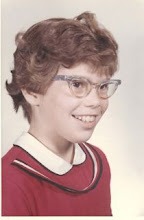Please help me welcome today's guest blogger, Mary Roderique. After teaching in New York City and Bloomington, IN, Mary Roderique relocated to Ann Arbor, MI, for more desirable weather conditions. She lives with her husband, children (4th grade and Kindergarten), and dog (who can read 3 words). She has worked as a classroom teacher and literacy and curriculum trainer since 1996. Currently, she works for Ann Arbor Public Schools as a Reading Intervention teacher. Hobbies include reading, blogging, ice skating, singing, and drinking coffee. Mary has been living the hocus-pocus for over 15 years and believes in the power of a good book, the power of workshop teaching, and the power of relationships. You can read more from Mary on her blog.
The Hocus Pocus of Working with Readers
Teaching reading is not really about book levels, guided reading, and miscue analysis. Teaching reading is about creating community. And the easiest way to create a community is with a little hocus-pocus, weaving purpose, initiative, and joy into instruction.
After I began teaching, I began having conversations with my class about us being the kind of people who talk to other people about books, who stay up too late reading a book because someone else is waiting for it, who bring a book just-in-case we have to wait because we’d have precious minutes to read! I scoured bookstores for books for my students, organized the classroom library, wrote grants to get them even more books. My class was buzzing. Books anchored our classroom community and it felt amazing to be in that space together.
Truth be told, I was busy: professional reading, developing curriculum, committee work, responding to student work, lunch duty, walking the dog, groceries. Phew. I started slipping.
One day when I opened my mouth to talk about our reading and writing lives at home, I realized that I was a big faker. While I was having some hocus pocus with my students, I wasn’t doing it myself. Sure, I was reading at home, I was writing at home, but only professional books for work. I wasn’t reading, writing, or living for me anymore. I was all talk. I went home from school that day, left my work bag closed, and got out a book. Later that week, I went to a movie with my husband on a school night. After school I started leaving a little earlier and rollerblading on the rail-to-trail on my way home. I was living the hocus-pocus: reading, writing, and actively pursuing my interests. It all got easier: the have-to’s and projects took less time because I was coming in at my best. And now, while I may sometimes need a reminder, I’ve now been living the hocus pocus for over 15 years, and the personal and professional impact still astounds me.
Hocus pocus is not just an academic goal, it’s about living well in the world in way that reading, writing, and connecting with each other matter. There are other ways to get the hocus pocus, but reading and stories seem to be the easiest way to help a group of people both come together and find themselves.
The real magic of the hocus pocus is this: you must truly believe it in your heart and live it yourself before you say the words to cast the spell to others. Purpose, initiative, and joy.
Top Five Tricks of Hocus Pocus for Readers in Elementary Classrooms
1. Anchor your classroom with books, both literally and figuratively. Read Aloud and the classroom library hold together teaching, learning, and community.
2. Have the right book for right now. If all a kid will look at is a puzzle book, then start with a puzzle book. Then watch what he/she likes and get what’s next, and what’s next, and what’s next after that. Finding entry points and matching books to readers is essential.
3. Leave ‘em and loan ‘em. Leave books around. At home, I leave a book I think will interest my kids on the coffee table. It almost always gets picked up. At school, I strategically place books front-facing in our library baskets that I think will be appealing. Sometimes, I leave a book in someone’s cubby, with a note to the reader telling why I think the book will interest him/her. Lend books with enthusiasm!
4. Read aloud what you love. Read aloud changes the world: it is interesting, it builds community, and it’s a valuable tool for instruction. Also, it models a commitment to sustained work.
5. Live the Hocus Pocus. Pursuing your own reading, writing, and interests will shape both your practice and personality. Empower yourself so you can empower your students.
Thank you Mary for sharing your story with us. What a great reminder to keep reading and writing so we can honestly inspire others to as well! And did you know that First Book might be able to help your school acquire books so you can conjure up even more hocus pocus? I'm an Author in Action so you can register through me here!





Mary is a gifted teacher and an amazing resource to all educators and parents.
ReplyDelete